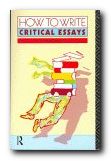sample from HTML program and PDF book
1. Approach
Essays can be composed using a number of different writing strategies. Some people write directly from rough notes, whilst others prefer a ‘discovery’ method. If you are in any doubt at all, you should plan your work. The task of writing is usually much easier if you create an outline structure for your arguments, with brief details of the topics to be covered. The stages of this process are as follows.
2. Analyse the question
Make sure that you understand what an essay question is asking for. What is it giving you the chance to write about? What is its central issue? Note carefully any of its key terms and any instructions. Think about the question, turning it over in your mind. Discuss it if possible with your fellow students. If you are in any doubt, ask your tutor to explain what is required.
3. Generate ideas
Take a sheet of paper and make a brief note of any topics that might be used for an answer. These can be ideas, observations, or information from your study materials. These topics will be used to make a plan. Don’t copy out chunks of texts. Use brief notes or even single word triggers. Write down anything you think of at this stage. Your objective is to generate ideas, to assemble a stock of potential material from which you will pick out the most appropriate items.
4. Choose topics
Take another sheet of paper. Extract from your list all those topics and points of argument which are of greatest relevance to the question and its central issue. You are simply picking out the best material. If it is possible, put your ideas in any logical groups or categories. If anything strikes you as irrelevant to the subject in question, throw it out.
5. Reading and research
Whilst writing essays, you will probably be engaged in reading or research in the subject. This will help you to provide information for an answer. Your reading will be more carefully directed if you have narrowed down the topics you need to cover in your response to a question. This is why it is important to think about the issues involved as a form of preliminary work on the question.
6. Selection
Select items on the strength of their relevance to the question. This may not be an easy judgement to make. Keep asking yourself – “Is this directly related to the subject? Will it answer the question?” You might have three categories of selection. One is a definite “Yes – this relevant”. The second could be like a ‘Pending’ tray containing items which might be used later. The third is a dustbin into which the completely unrelated material is thrown for good.
7. Create order
Take yet another sheet of paper. Try to arrange your chosen topics and material in some sort of order. At this stage you should be starting to formulate your basic response to the question. Organise the points so that they form a persuasive and coherent pattern or argument. Some subjects will lend themselves more easily to the creation of this order than others. In some, such as appreciation of the arts, there may be no set pattern and one must be created. In some of the sciences, there may be a standard form of report which must be followed. This is probably the hardest part of essay planning at a conceptual level.
8. Arrange evidence
Most of the major points in your argument will need to be supported by evidence. One purpose of the essay task is to show that you have read widely in your subject and considered the opinions of others. In some subjects you may actually need proof to support your arguments. During the process of study you have probably been assembling notes and references for just such a purpose. If not, this is the time to do so. On another sheet of paper you might compile a list of brief quotations from other sources (don’t forget the page references) which will be offered as your evidence.
9. Material
Don’t worry too much if you have surplus evidence after completing this stage. This is perfectly normal. You can pick out the best from what is available. If on the other hand you don’t have enough, you should do more background reading or engage with the subject once again. Take some more notes or generate new ideas as material to work on.
10. Make changes
Whilst you have been engaged in the first stages of planning, new ideas may have come to mind. Alternate sources of evidence may have occurred to you, or the line of your argument may have shifted somewhat. Be prepared at this stage to rearrange your plan so that it incorporates any new materials. Try out different arrangements of your topics until they form the most convincing and logical sequence.
11. Make plan
Most essay plans can be summarised in this form:
- Introduction
- Arguments
- Conclusion
State your case as briefly and as directly as possible. Next, present your arguments and your evidence in the body of the essay, explaining their relevance to the original question. Finally, draw together the points of your arguments and try to lift them to a higher level in your conclusion. Your final plan may be something like a list of half a dozen to ten major points of argument. Each of these, together with their supporting evidence, will be expanded to a paragraph of something around 100-200 words. This is the heart of essay planning.
12. First draft
You are now ready to produce the first draft of the essay. Don’t imagine that you are supposed to produce an accomplished piece of writing at one sitting. These will be your first thoughts and your initial attempts at answering the question. Later drafts can be improved by re-writing. You will be matching your evidence to what is required. You do not necessarily need to start at the introduction and work systematically towards your conclusion: it may be better to start working where you feel most comfortable.
13. Relevance
At all stages of essay writing, you should keep the question in mind. Keep asking yourself “Is this evidence directly relevant to the topic I have been asked to discuss?” If necessary, be prepared to scrap your first attempts and formulate new arguments. This may seem painful, but it will be much easier than scrapping finished essays.
14. Paragraphs
A good tip on relevance is to check that the opening statement of each major paragraph is directly related to the question. The first sentence (which is sometimes called the topic sentence’) should be a direct response to what you have been asked. It might be an example to illustrate your answer, or a major point of your argument on the subject in question. If it is not, something may be wrong.
15. Revising the draft
Your first draft is the basic material from which you will be building the finished product. Be prepared to re-write it in whatever way is necessary. If it is too short, generate more arguments. If it is too long, cut out the less relevant parts. If it doesn’t seem convincing, consider putting its arguments in a different order. You might begin to tidy up the grammar and style at this stage.
16. Multiple drafts
The number of drafts you make will depend upon the time you have available (and possibly the importance of the piece of work). It is very useful to take your work through a number of drafts, re-writing where necessary. In the majority of cases, this will improve the quality of what you produce.
17. Editing
Before actually submitting the piece of work, you should take it through at least one stage of rigorous presentation of your work will enhance its effectiveness. Create a neat, legible text; double-space your paragraphs and leave wide margins to ‘frame’ what you have written. Take pride in the work you produce. Keep essays in a loose-leaf folder or a document wallet. Alternatively, use one of the plastic envelopes which are now increasingly popular. Remember that your essays will be of critical importance during the period of revising for examinations.
© Roy Johnson 2003
Buy Writing Essays — eBook in PDF format
Buy Writing Essays 3.0 — eBook in HTML format
More on How-To
More on writing essays
More on writing skills

